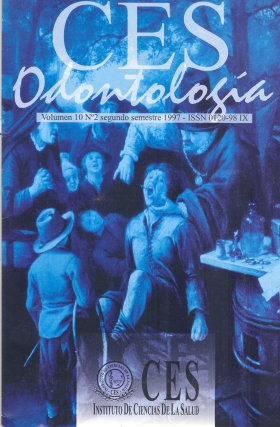COMPARACIÓN DE LA MICROFILTRACIÓN MARGINAL ENTRE UNA RESTAURACIÓN DE AMALGAMA Y EL DIENTE UTILIZANDO 3 MATERIALES INTERMEDIOS. in vitro
Resumen
Ultimamente se ha discutido sobre la capacidad de las amalgamas de brindar por sí solas un selle marginal que evite la microfiltración entre diente-restauración. Este estudio, compara la capacidad para evitar o disminuir la microfiltración marginal usando tres materiales intermedios: Copalyte, Amalgam Liner y Amalgambond. En el estudio in vitro, se prepararon cavidades clase I en 60 dientes premolares extraídos de humanos por indicaciones ortodónticas, y se dividieron en 4 grupos de 15 dientes cada uno. En el grupo 1 se obturaron las cavidades sólo con amalgamas de fase dispersa (Nu Alloy). Para los grupos 2, 3 y 4 se utilizaron materiales intermedios (Copalyte, Amalgam Liner, Amalgambond) respectivamente y se obturaron con la amalgama antes mencionada. Posteriormente fueron inmersos en una solución acuosa de Fuccina Básica al 1% durante 12 días. Luego fueron seccionados bucolingualmente y observados al microscopio de luz en 100X. Los resultados indicaron que los materiales intermedios sirven para evitar o disminuir la microfiltración marginal, al menos en los primeros 12 días después de realizada la restauración. El Amalgam Liner y el Amalgambond fueron los materiales intermedios que mejor evitaron la microfiltración. El Copalyte demostró en menor grado, capacidad para evitar la microfiltración marginal. Las restauraciones en las que no se utilizo ningún material intermedio, fueron las que mayor microfiltración permitieron. ABSTRACT Much has been discussed about the ability of amalgams to offer by themselves an adequate marginal seal that prevents microleakage between the tooth and the restoration. This study compares the capacity to avoid or diminish the marginal leakage when three intermediate materials: Copalyte, Amalgam Liner, Amalgambond, are used. In this in vitro study, class I cavities were prepared in 60 Human extracted Premolars, and they were divided in 4 groups of 15 teeth each one. In group number 1, the prepared cavities were obturated only with disperse phase amalgam (Nu Alloy). For groups 2, 3 and 4, intermediate materials were utilized (Copalyte, Amalgam Liner, Amalgambond respectively); and then, they were obturated with the same type of amalgam already mentioned. Subsequently, They were immersed in an aqueous Basic Fuccin 1% solution during 12 days. Then, they were sectioned buccolingually and observed under the light microscope at 100X. The findings indicated that the intermediate materials served to prevent marginal microleakage, at least during the first 12 days after the restoration was placed. Amalgam Liner and Amalgambond were the intermediate materials that best prevented marginal microleakage. Copalyte showed, in a lesser degree, capacity to prevent marginal microleakage. The restorations in which no intermediate material was utilized, were the ones that showed the largest amount of microleakage.Descargas
Los datos de descargas todavía no están disponibles.
Descargas
Publicado
2010-06-29
Cómo citar
1.
Trujillo Ocampo G, Restrepo J, Uribe S. COMPARACIÓN DE LA MICROFILTRACIÓN MARGINAL ENTRE UNA RESTAURACIÓN DE AMALGAMA Y EL DIENTE UTILIZANDO 3 MATERIALES INTERMEDIOS. in vitro. CES odontol. [Internet]. 29 de junio de 2010 [citado 23 de abril de 2024];10(2). Disponible en: https://revistas.ces.edu.co/index.php/odontologia/article/view/1139
Número
Sección
Artículo de Investigación Científica y Tecnológica
| Estadísticas de artículo | |
|---|---|
| Vistas de resúmenes | |
| Vistas de PDF | |
| Descargas de PDF | |
| Vistas de HTML | |
| Otras vistas | |



